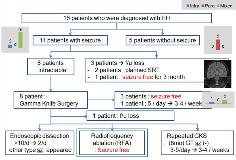Surgical Outcome of Hypothalamic Hamartoma
Abstract number :
2.325
Submission category :
9. Surgery / 9B. Pediatrics
Year :
2018
Submission ID :
499564
Source :
www.aesnet.org
Presentation date :
12/2/2018 4:04:48 PM
Published date :
Nov 5, 2018, 18:00 PM
Authors :
JooYoung Song, Samsung Medical Center; Jung-Il Lee, Samsung Medical Center; Hyung Jin Shin, Samsung Medical Center; Jeehun Lee, Samsung Medical Center; and Jiwon Lee, Samsung Medical Center
Rationale: Hypothalamic hamartoma (HH) is a rare congenital disorder still requiring further evidences about the treatment. The aim of this study was to analyze the surgical outcome of HH for optimizing the surgical candidate and timing. Methods: This study included 16 patients were diagnosed with HH at Samsung Medical Center from 1997 to 2018 and a retrospective review of their medical records was conducted. We reviewed the presenting symptoms, brain magnetic resonance imaging (MRI) finding, treatments, and response to the treatment. Results: The mean age of diagnosis was 2.76 ± 2.71 years old. The first presenting symptom was seizure in 6 patients (37.5%), precocious puberty in 4 patients (25%), and 5 patients (31.3%) presented the both. One patient was incidentally diagnosed with HH without any symptom. According to radiologic classification based on brain MRI, the patients with intrahypothalamic type (n = 2, 12.5%) did not present precocious puberty and those with parahypothalamic type (n = 5, 31.3 %) did not present seizure. Nine patients with mixed hypothalamic type (56.3 %) all had seizure, and 5 of them showed both of seizure and precocious puberty. In 11 patients who initially presented seizure, all had gelastic seizure except one with complex partial seizure. Two patients (18.1%) partially responded to antiepileptic medications, and the rest 9 patients (81.8%) had intractable seizures. Eight patients were treated with gamma-knife radiosurgery (GKS) for intractable epilepsy, 3 patients showed a response to the treatment, and one patient showed a decreased frequency of seizure. In addition, there were 3 patients responded to repeated GKS, radiofrequency ablation (RFA), and endoscopic dissection. Conclusions: Intractable epilepsy in patients with HH was the most frequent indication of surgery. GKS was suitable and safe in most patients and effective in 75% of subjects. RFA could be considered in patients with refractory to GKS. Funding: This abstract was not supported by any funding.
